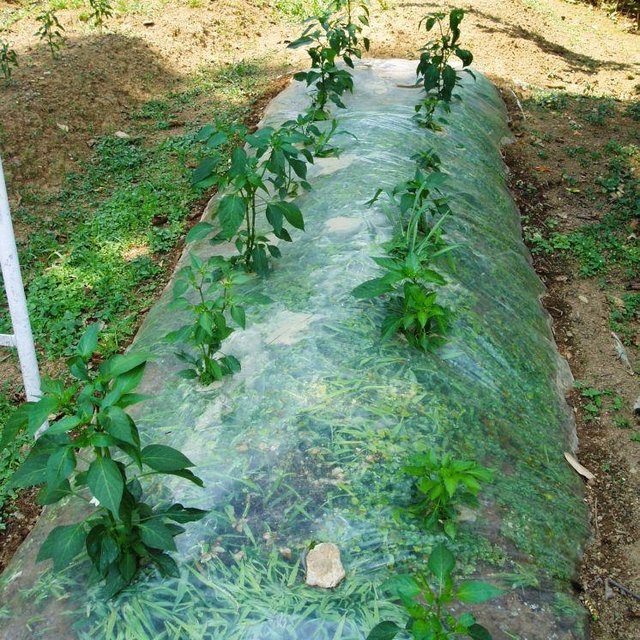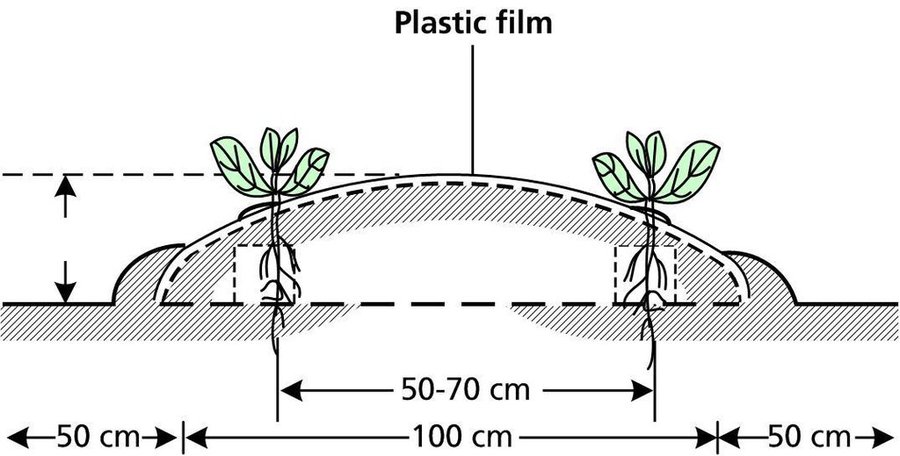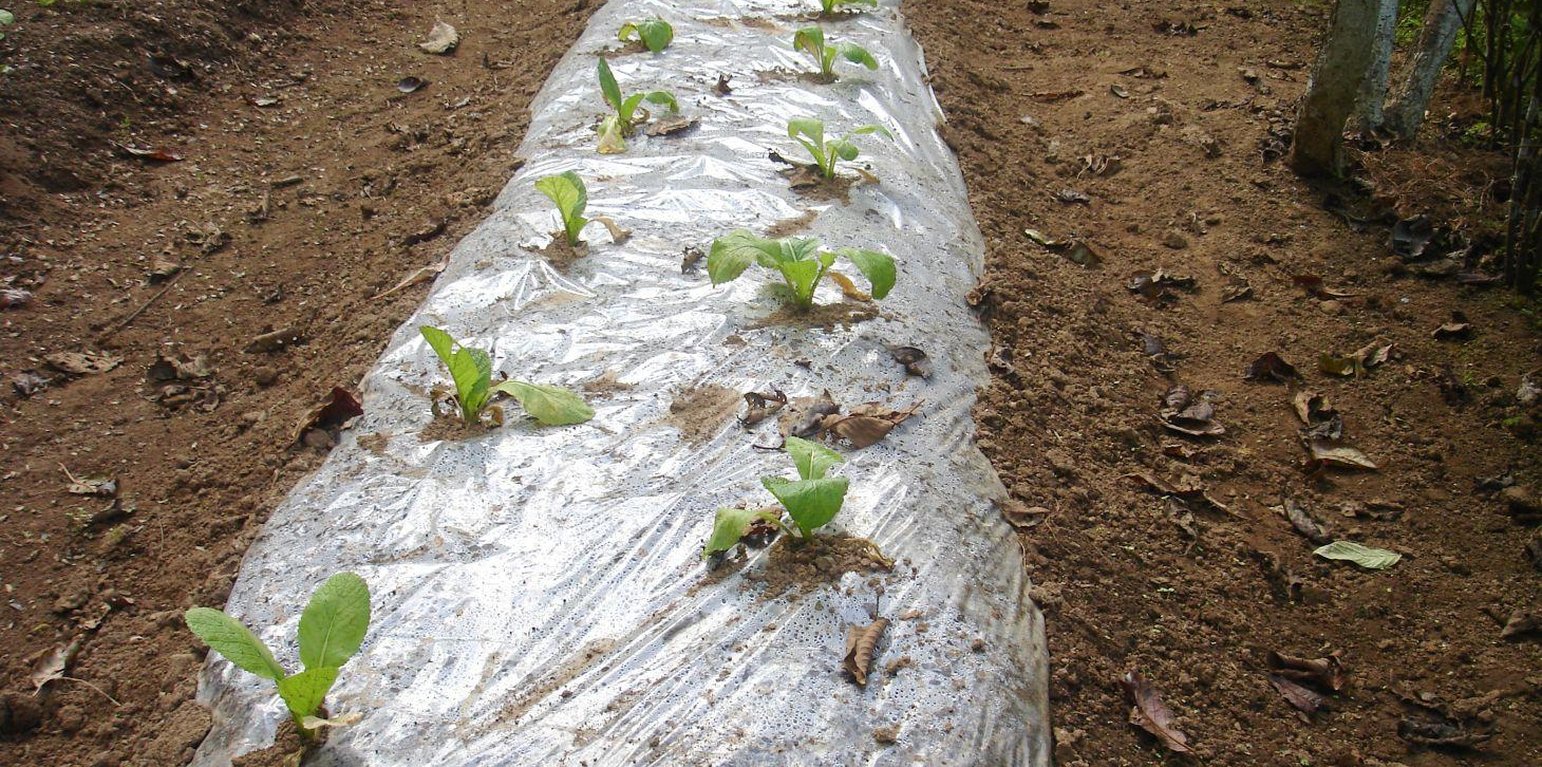Plastic film technology
(Népal)
Plastic proyog gari kheti garne prabidhi (Main Contributor: Samden Sherpa, ICIMOD)
Description
Plastic film technology, sometimes called plastic mulching, is an important breakthrough that can transform traditional agriculture into modern agriculture by helping to circumvent many of the limitations of temperature and moisture. Plastic film is used to cover the surface of the soil in order to increase the temperature, to retain moisture, and to promote the germination of seeds.
Agricultural production by traditional methods is constrained by extremes in temperature and by extremes in the availability of water; freezing temperatures as well as droughts and waterlogging have long daunted farmers. When plastic film is used on the soil, the solar energy absorbed by the soil during the day is retained at night since the plastic film prevents water from evaporating. Higher night time temperatures and higher levels of moisture in the ground promote active micro-organisms, which diminish the need for fertilizer and improve the physical properties of the soil.
Purpose of the Technology: Plastic film can be used in one of two ways. In the first method, the plastic film is spread on ridges of soil, the plastic is perforated at regular intervals, and the seedlings are planted through these openings. In the other method, seeds are planted on the ridges as in the traditional method, and when the seedlings have grown to a reasonable size, the ridge is covered by a plastic film and holes are cut at the position of the seedlings to allow them to pass through the film. Depending on the condition of the film after the crops are harvested, the covered ridges can be used to grow another crop.
Establishment / maintenance activities and inputs: Experiments at ICIMOD show that the use of plastic film can, on average, double the crop yield as compared to traditional methods. Previous studies by Lu Rongsen (1994) showed that the plastic film method can increase chilli production by 74%, tomato production by 52%, and the production of garden peas by 31%.
Lieu
![]()
Lieu: Lalitpur District, Népal
Nbr de sites de la Technologie analysés:
Géo-référence des sites sélectionnés
Diffusion de la Technologie: répartie uniformément sur une zone
Dans des zones protégées en permanence ?:
Date de mise en oeuvre:
Type d'introduction
-
grâce à l'innovation d'exploitants des terres
-
dans le cadre d'un système traditionnel (> 50 ans)
-
au cours d'expérimentations / de recherches
-
par le biais de projets/ d'interventions extérieures

Method #2 Chilli seeds are planted directly in the ground, when the seedlings are a few centimetres high the entire ridge is covered by a plastic film and holes are punched into the plastic allowing the seedlings to emerge. Unwanted weeds are left under t (KM sthapit)
Classification de la Technologie
Principal objectif
-
améliorer la production
-
réduire, prévenir, restaurer les terres dégradées
-
préserver l'écosystème
-
protéger un bassin versant/ des zones situées en aval - en combinaison avec d'autres technologies
-
conserver/ améliorer la biodiversité
-
réduire les risques de catastrophes
-
s'adapter au changement et aux extrêmes climatiques et à leurs impacts
-
atténuer le changement climatique et ses impacts
-
créer un impact économique positif
-
créer un impact social positif
L'utilisation des terres
-
Terres cultivées
Nombre de période de croissance par an: : 2
-
Forêts/ boisProduits et services: Bois de chauffage, Autres produits forestiers
Approvisionnement en eau
-
pluvial
-
mixte: pluvial-irrigué
-
pleine irrigation
But relatif à la dégradation des terres
-
prévenir la dégradation des terres
-
réduire la dégradation des terres
-
restaurer/ réhabiliter des terres sévèrement dégradées
-
s'adapter à la dégradation des terres
-
non applicable
Dégradation des terres traité
-
dégradation hydrique - Ha: aridification
Groupe de GDT
-
Amélioration de la couverture végétale/ du sol
Mesures de GDT
-
modes de gestion - M7: Autres
Dessin technique
Spécifications techniques
The diagram shows a cross-section of a ridge planted using plastic film technology. The plants grow through holes punched in the plastic. The plastic helps to retain moisture in the soil and, in so doing, also helps to increase the soil temperature. Weeds trapped below the plastic are inhibited from interfering with the crop.
The ridges (or beds) are typically 20 m long, 1 m wide and spaced 1 m apart (for access); they are usually 10–20 cm high. The distances shown in the diagram are averages for crops such as chillies where the row-to-row distance is 50–70 cm and the plant-to plant distance is 40–50 cm. These distances vary according to the crop.
Technical knowledge required for land users: moderate
Main technical functions: Increase the temperature of the soil and promote seed germination and emergence, Retain soil moisture and reduce soil erosion
Secondary technical functions: Accelerates the growth and development of roots and plants in areas where the temperature is low dur, Hastens maturation of crops and increase yield and promote good quality crop
Change of land use practices / intensity level

Author: AK Thaku
Mise en œuvre et entretien : activités, intrants et coûts
Calcul des intrants et des coûts
- Les coûts sont calculés : par superficie de la Technologie (taille et unité de surface : ha)
- Monnaie utilisée pour le calcul des coûts : dollars américains
- Taux de change (en dollars américains - USD) : 1 USD = n.d.
- Coût salarial moyen de la main-d'oeuvre par jour : n.d.
Facteurs les plus importants affectant les coûts
This was a demonstration project conducted by ICIMOD.
All costs and amounts are rough estimates by the technicians and authors.
Activités de mise en place/ d'établissement
-
The plot of land to be planted is prepared by first fertilizing it with a mixture of soil, compost, and/or farmyard manure. The soil is gathered into parallel ridges, typically 20 m long, 1 m wide, and 10–20 cm high; the distance between two ridges is usually 40–50 cm. For many crops the seedlings are spaced 50–70 cm apart. (Calendrier/ fréquence: None)
-
Method #1 Plastic film (approx. thickness 0.014–0.003 mm) is used to cover the ridges and anchored into the ground. Round holes are punched in the film at regular intervals. Some soil is excavated through the holes and the seedlings are planted through the holes and thoroughly watered. The holes in the plastic are sealed using soil. (Calendrier/ fréquence: None)
-
Method#2 Seeds are sown on the ridges and seedlings are allowed to develop. The ridge is covered in plastic film and the film is anchored. Holes are punched into the plastic at the position of the seedlings so that they pass through. (Calendrier/ fréquence: None)
-
For either method, when the crops are harvested all residue should be removed. Depending on local conditions and on whether the plastic film is still viable, the plastic covered ridges can be reused to grow another crop without replacing the film. (Calendrier/ fréquence: None)
Intrants et coûts de mise en place (per ha)
| Spécifiez les intrants |
Unité |
Quantité |
Coûts par unité (dollars américains) |
Coût total par intrant (dollars américains) |
% des coût supporté par les exploitants des terres |
|
Main d'œuvre
|
| Preparing land plot |
persons/day/ha |
80,0 |
3,875 |
310,0 |
|
|
Equipements
|
| Spade, secateurs |
ha |
1,0 |
10,0 |
10,0 |
|
| Plastic film |
kg/ha |
48,0 |
1,0 |
48,0 |
|
|
Matériel végétal
|
| Seedlings |
ha |
1,0 |
250,0 |
250,0 |
|
| Coût total de mise en place de la Technologie |
618.0 |
|
| Coût total de mise en place de la Technologie en dollars américains (USD) |
618.0 |
|
Activités récurrentes d'entretien
-
Provide crop support such as staking and removal of excess leaves as required (Calendrier/ fréquence: None)
Intrants et coûts de l'entretien (per ha)
| Spécifiez les intrants |
Unité |
Quantité |
Coûts par unité (dollars américains) |
Coût total par intrant (dollars américains) |
% des coût supporté par les exploitants des terres |
|
Main d'œuvre
|
| Support the crops |
persons/day/ha |
30,0 |
3,6668 |
110,0 |
|
|
Equipements
|
| Bamboo poles |
ha |
1,0 |
20,0 |
20,0 |
|
| Coût total d'entretien de la Technologie |
130.0 |
|
| Coût total d'entretien de la Technologie en dollars américains (USD) |
130.0 |
|
Environnement naturel
Précipitations annuelles
-
< 250 mm
-
251-500 mm
-
501-750 mm
-
751-1000 mm
-
1001-1500 mm
-
1501-2000 mm
-
2001-3000 mm
-
3001-4000 mm
-
> 4000 mm
Zones agro-climatiques
-
humide
-
subhumide
-
semi-aride
-
aride
Spécifications sur le climat
Thermal climate class: temperate
Pentes moyennes
-
plat (0-2 %)
-
faible (3-5%)
-
modéré (6-10%)
-
onduleux (11-15%)
-
vallonné (16-30%)
-
raide (31-60%)
-
très raide (>60%)
Reliefs
-
plateaux/ plaines
-
crêtes
-
flancs/ pentes de montagne
-
flancs/ pentes de colline
-
piémonts/ glacis (bas de pente)
-
fonds de vallée/bas-fonds
Zones altitudinales
-
0-100 m
-
101-500 m
-
501-1000 m
-
1001-1500 m
-
1501-2000 m
-
2001-2500 m
-
2501-3000 m
-
3001-4000 m
-
> 4000 m
La Technologie est appliquée dans
-
situations convexes
-
situations concaves
-
non pertinent
Profondeurs moyennes du sol
-
très superficiel (0-20 cm)
-
superficiel (21-50 cm)
-
modérément profond (51-80 cm)
-
profond (81-120 cm)
-
très profond (>120 cm)
Textures du sol (de la couche arable)
-
grossier/ léger (sablonneux)
-
moyen (limoneux)
-
fin/ lourd (argile)
Textures du sol (> 20 cm sous la surface)
-
grossier/ léger (sablonneux)
-
moyen (limoneux)
-
fin/ lourd (argile)
Matière organique de la couche arable
-
abondant (>3%)
-
moyen (1-3%)
-
faible (<1%)
Profondeur estimée de l’eau dans le sol
-
en surface
-
< 5 m
-
5-50 m
-
> 50 m
Disponibilité de l’eau de surface
-
excès
-
bonne
-
moyenne
-
faible/ absente
Qualité de l’eau (non traitée)
-
eau potable
-
faiblement potable (traitement nécessaire)
-
uniquement pour usage agricole (irrigation)
-
eau inutilisable
La qualité de l'eau fait référence à:
La salinité de l'eau est-elle un problème ?
Présence d'inondations
Caractéristiques des exploitants des terres appliquant la Technologie
Orientation du système de production
-
subsistance (auto-approvisionnement)
-
exploitation mixte (de subsistance/ commerciale)
-
commercial/ de marché
Revenus hors exploitation
-
moins de 10% de tous les revenus
-
10-50% de tous les revenus
-
> 50% de tous les revenus
Niveau relatif de richesse
-
très pauvre
-
pauvre
-
moyen
-
riche
-
très riche
Niveau de mécanisation
-
travail manuel
-
traction animale
-
mécanisé/ motorisé
Sédentaire ou nomade
-
Sédentaire
-
Semi-nomade
-
Nomade
Individus ou groupes
-
individu/ ménage
-
groupe/ communauté
-
coopérative
-
employé (entreprise, gouvernement)
Âge
-
enfants
-
jeunes
-
personnes d'âge moyen
-
personnes âgées
Superficie utilisée par ménage
-
< 0,5 ha
-
0,5-1 ha
-
1-2 ha
-
2-5 ha
-
5-15 ha
-
15-50 ha
-
50-100 ha
-
100-500 ha
-
500-1 000 ha
-
1 000-10 000 ha
-
> 10 000 ha
Échelle
-
petite dimension
-
moyenne dimension
-
grande dimension
Propriété foncière
-
état
-
entreprise
-
communauté/ village
-
groupe
-
individu, sans titre de propriété
-
individu, avec titre de propriété
Droits d’utilisation des terres
-
accès libre (non organisé)
-
communautaire (organisé)
-
loué
-
individuel
Droits d’utilisation de l’eau
-
accès libre (non organisé)
-
communautaire (organisé)
-
loué
-
individuel
Accès aux services et aux infrastructures
Impact
Impacts socio-économiques
Production agricole
en baisse
en augmentation
in areas with a long winter season
revenus agricoles
en baisse
en augmentation
less time is spent weeding
Impacts socioculturels
connaissances sur la GDT/ dégradation des terres
livelihood and human well-being
improved crops and higher yields benefit the entire community because more food is available and the harvest brings in cash income.
Impacts écologiques
humidité du sol
en baisse
en augmentation
soil erosion and nutrient loss
discarded plastic
not biodegradable
biodegradable
Impacts hors site
inondations en aval (indésirables)
Downstream farmers benefit because soil is conserved and runoff is reduced
Analyse coûts-bénéfices
Bénéfices par rapport aux coûts de mise en place
Rentabilité à court terme
très négative
très positive
Rentabilité à long terme
très négative
très positive
Bénéfices par rapport aux coûts d'entretien
Rentabilité à court terme
très négative
très positive
Rentabilité à long terme
très négative
très positive
Changement climatique
Autres conséquences liées au climat
long spell of low temperature, frost and snowfall
pas bien du tout
très bien
Adoption et adaptation de la Technologie
Pourcentage d'exploitants des terres ayant adopté la Technologie dans la région
-
cas isolés/ expérimentaux
-
1-10%
-
11-50%
-
> 50%
Parmi tous ceux qui ont adopté la Technologie, combien d'entre eux l'ont fait spontanément, à savoir sans recevoir aucune incitation matérielle ou aucun paiement ?
-
0-10%
-
11-50%
-
51-90%
-
91-100%
La Technologie a-t-elle été récemment modifiée pour s'adapter à l'évolution des conditions ?
A quel changement ?
-
changements/ extrêmes climatiques
-
évolution des marchés
-
la disponibilité de la main-d'œuvre (par ex., en raison de migrations)
Conclusions et enseignements tirés
Points forts: point de vue de l'exploitant des terres
Points forts: point de vue du compilateur ou d'une autre personne-ressource clé
-
Plastic film technology can increase the yield of some crops by as much as 100% as compared to conventional farming.
How can they be sustained / enhanced? Since this technology is still relatively new, it will be necessary to continue sharing experiences and to promote awareness.
-
Plastic film technology can be used to grow crops in hilly areas where the long winter season is usually too cold to support crops.
How can they be sustained / enhanced? Need to create greater awareness of the benefits of using plastic film technology in mountain areas
Faiblesses/ inconvénients/ risques: point de vue de l'exploitant des terrescomment surmonter
Faiblesses/ inconvénients/ risques: point de vue du compilateur ou d'une autre personne-ressource clécomment surmonter
-
As farmers begin to use plastic film technology more plastic is being discarded in rural areas.
Plastic film needs to be retrieved and recycled. In China it has been shown that this is possible.
-
Discarded plastic film can pollute agricultural lands
Farmers need to be made aware of hazards and encouraged to form networks for collection and recycling the used plastic.
Références
Examinateur
-
David Streiff
-
Alexandra Gavilano
Date de mise en oeuvre: 12 août 2015
Dernière mise à jour: 4 juin 2019
Personnes-ressources
-
Shreedip Sigdel - Spécialiste GDT
-
Samden Lama Sherpa - Spécialiste GDT
Description complète dans la base de données WOCAT
Données de GDT correspondantes
La documentation a été facilitée par
Institution
- ICIMOD International Centre for Integrated Mountain Development (ICIMOD) - Népal
Projet
Références clés
-
The application of plastic film technology in China: Plastic film technology data collected and analyzed in ICIMOD D&T Centre, Godavari. Kathmandu, Nepal: ICIMOD, Rongsen, L (1994):









